“State Your Case” – Raising the Federal Minimum Wage: Part II
Samantha Badr
Welcome to Part II of “State Your Case”. In Part I, the potential benefits of raising the federal minimum wage were discussed. Now that we’ve heard the prosecution, it’s time for the defense to cross-examine the “potential benefits”. Make sure to click on this post and leave a comment to share your testimonies!
As mentioned in Part I, raising the federal minimum wage could increase employee retention and reduce turnover. However, it might be more difficult to retain employees if half of their co-workers are let go or replaced. If the government rules that businesses must pay more per worker, it could force businesses to let go of workers, or avoid hiring people altogether. The unemployment rate could increase – resulting in employees competing for fewer jobs.
A 2019 report by the Congressional Budget Office estimates that raising the minimum wage to $15 an hour by 2025 would result in the loss of approximately 1.3 million jobs. Although employees would enjoy a pay increase, businesses will have to foot the bill. Companies might be forced to outsource and move their facilities to countries with lower labor costs. Since robots can perform simple service tasks and even tasks in food preparation, health care, etc. – the demand for service-industry jobs will also plummet. Reduced employee turnover could be from employees fearing to lose their jobs in a scarce job market, rather than increased employee retention.
Another potential benefit that was previously discussed was economic growth. Even if that was the reality, an increase in federal wages could raise the cost of living in some areas. Landlords could raise rent knowing that employees will have more money to spend on housing, creating inflation. Additionally, the cost of goods and services could increase. A 2015 Purdue University study found that raising the federal minimum wage would result in higher prices for goods and/or reductions in product size – claiming that fast-food restaurants could have hamburgers that are much smaller. Another study by NBC News found that the price of a cup of coffee went up by 10-20% in California after a minimum wage increase. How could we possibly survive if our morning fuel suddenly doubled in price?
Economic growth might not be the case. Raising wages has the potential to put more money in the hands of consumers but what if their hands are still empty? The Federal Reserve Bank of Cleveland found that even if low-income workers see increases in wages, their hours and employment decline. The higher prices are, the smaller the demand for goods and the workers producing them. If people don’t have the money to spend on consumer goods – our economy, and our people, simply cannot flourish.
The defense rests.
Now that the prosecution and defense have presented their cases – what does the jury think? President Biden’s relief package might not happen tomorrow or next week, but many have speculated that it is likely to pass. Whether we agree with an increase in the federal minimum wage or not – the government wheels will keep on turning. As for the HR professionals of the world, it’s our job to make sure the pros always outweigh the cons.


